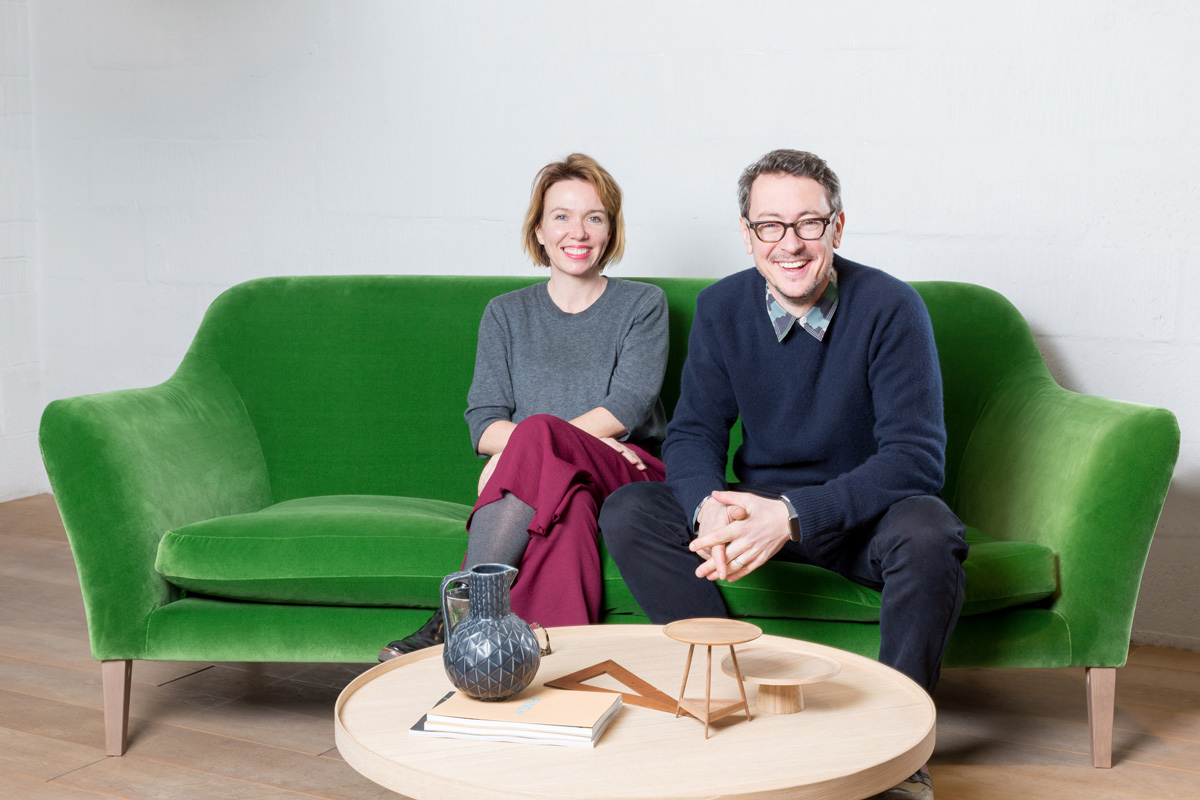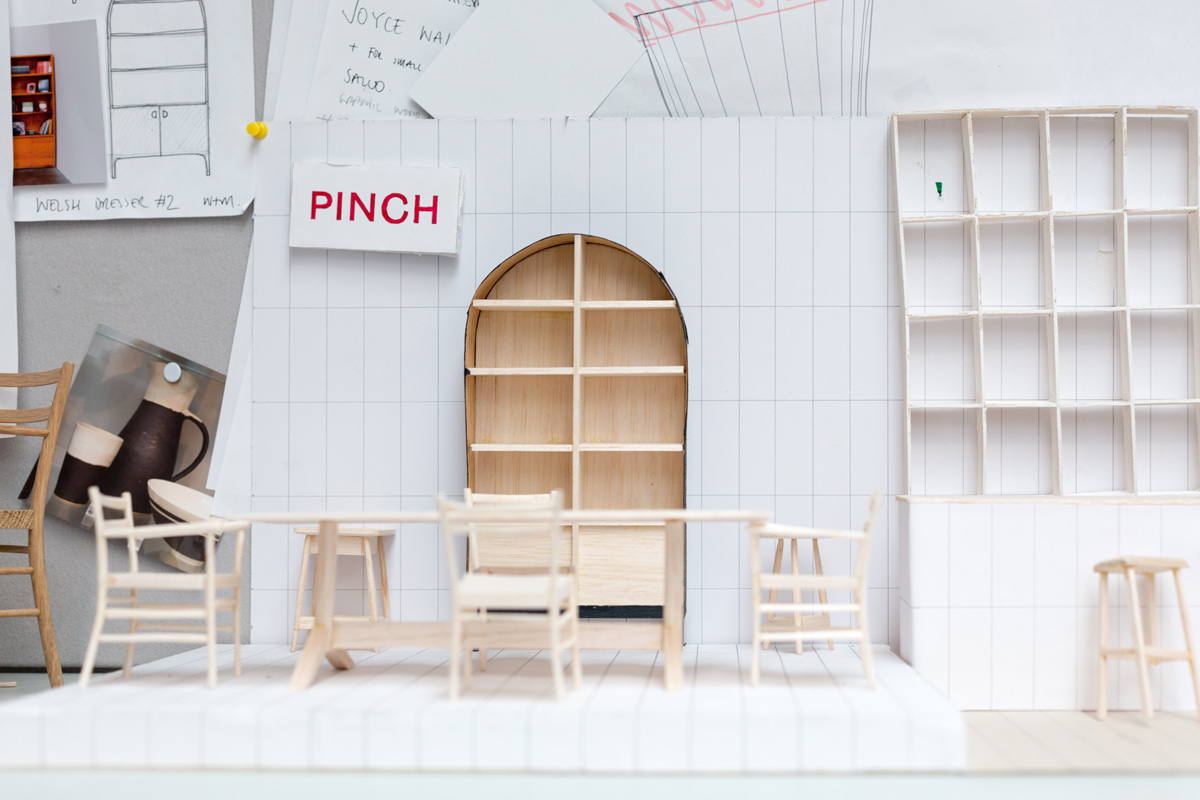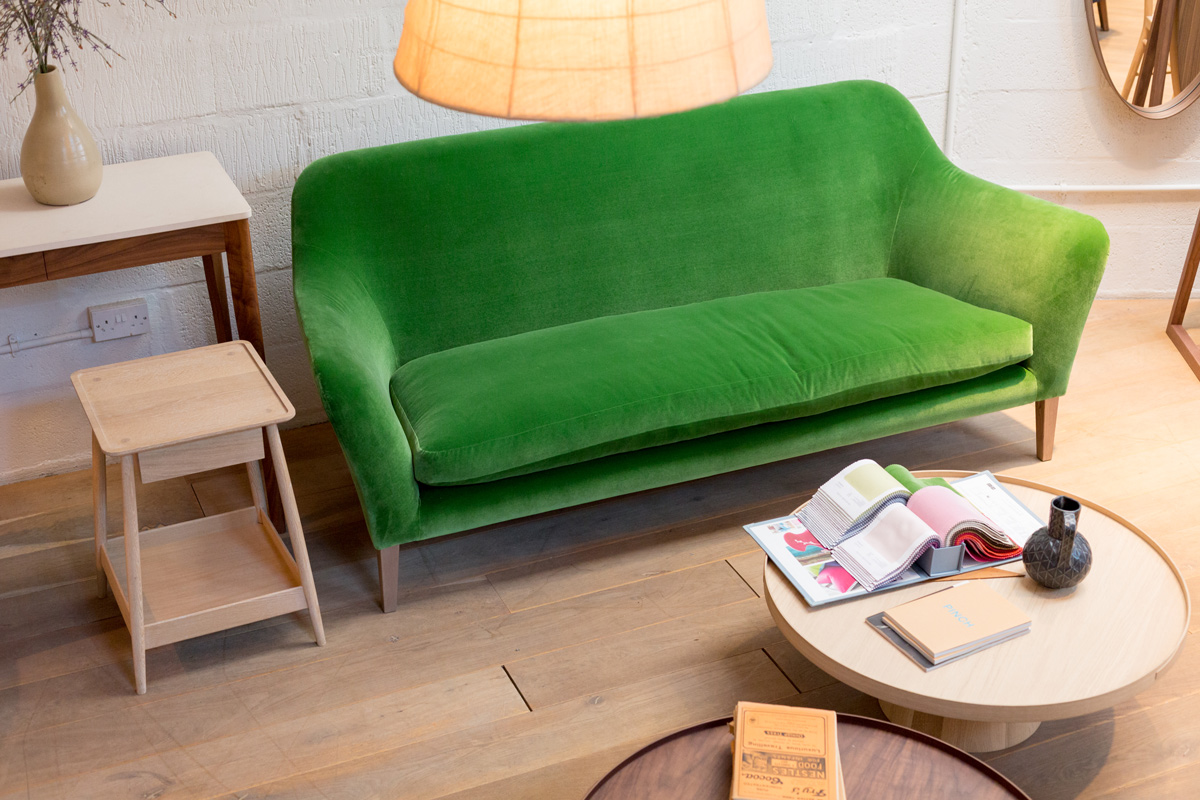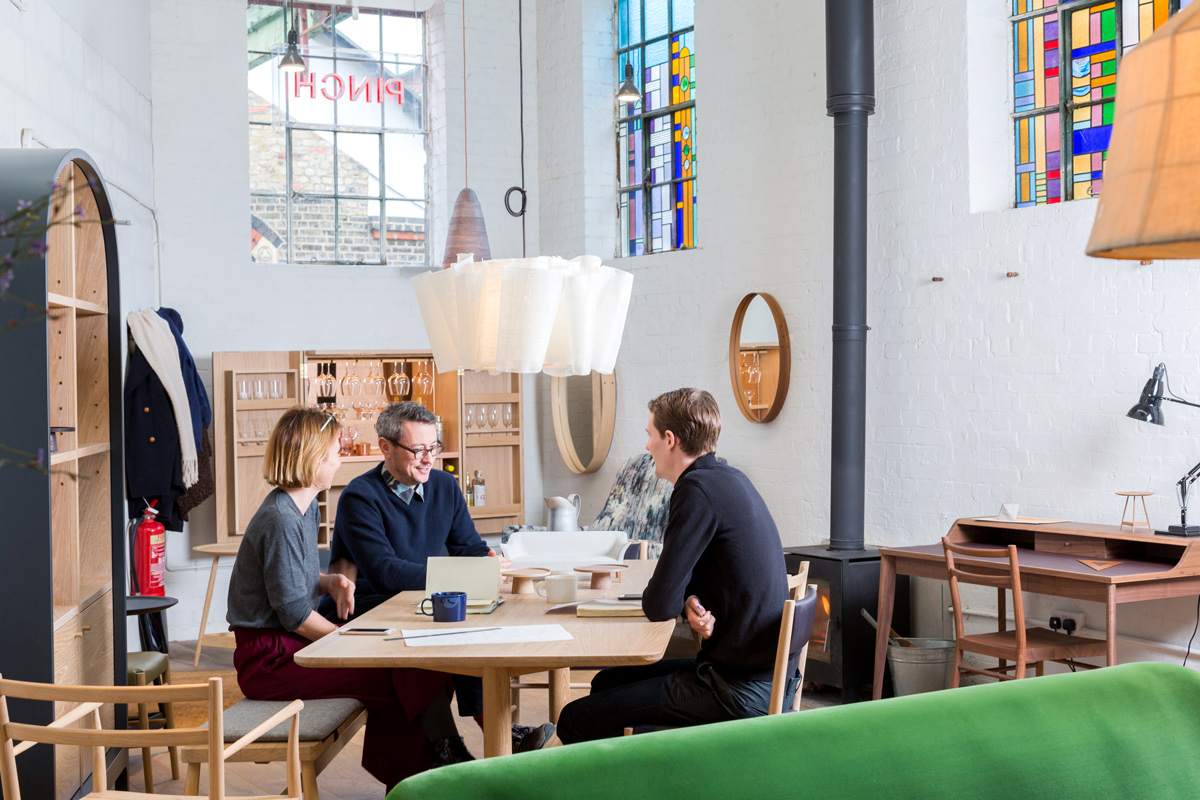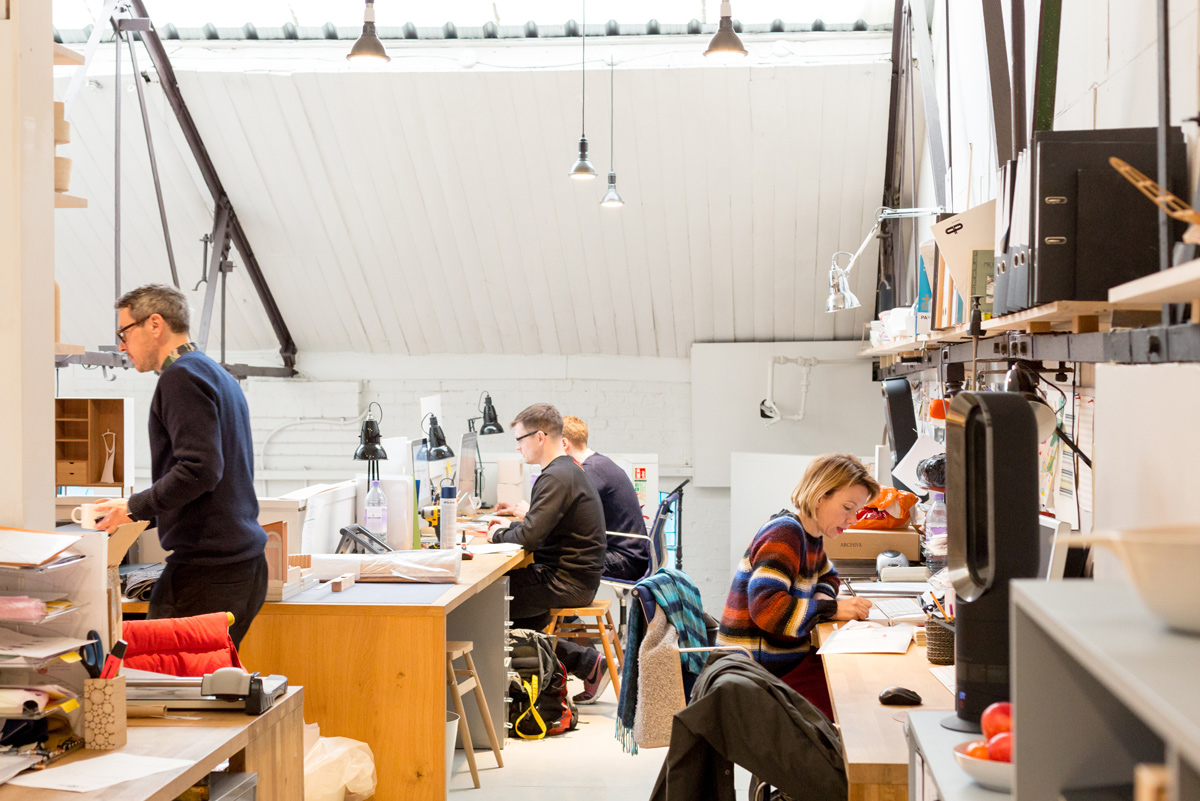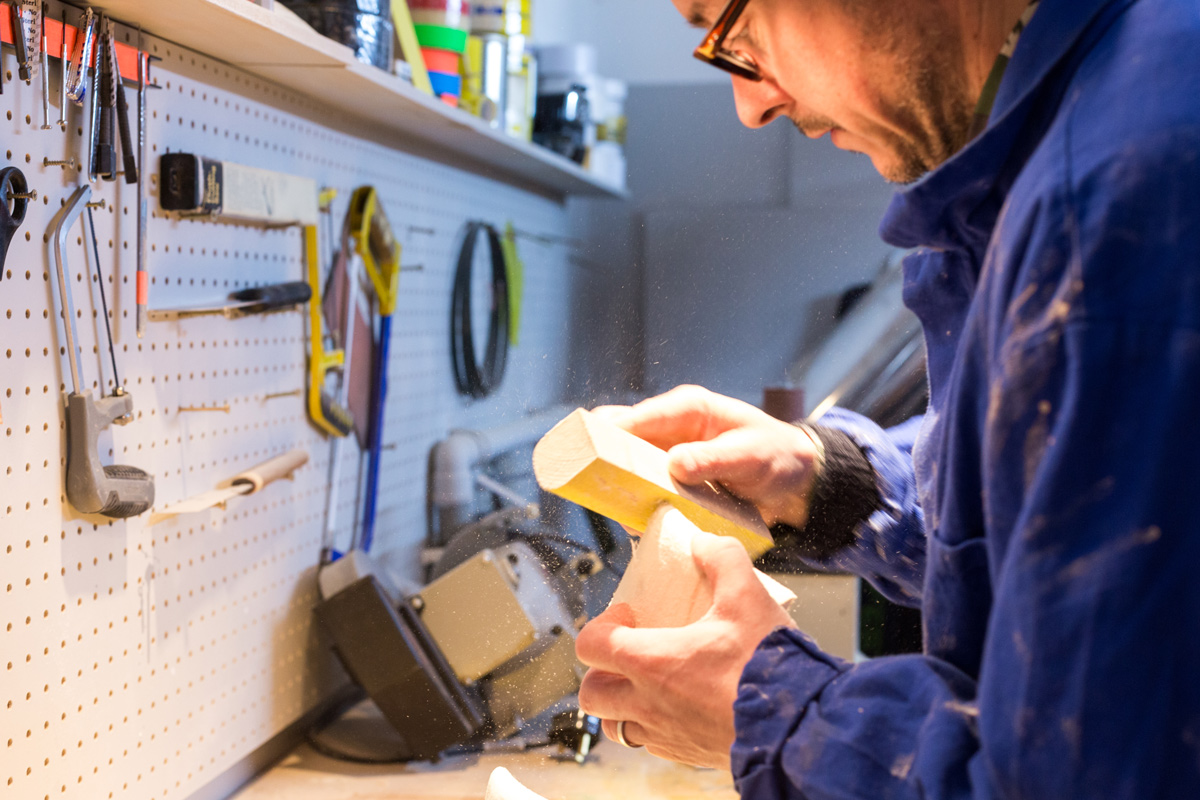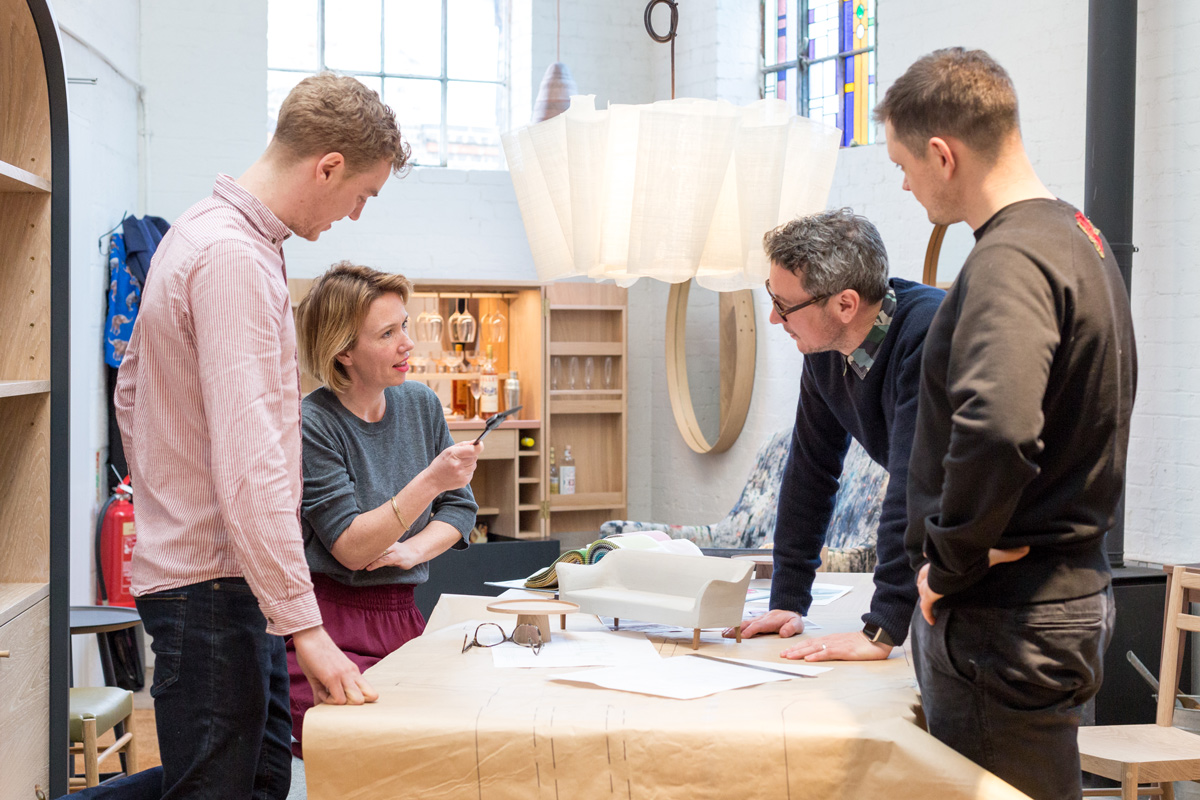PINCH us, we must be dreaming! At least that was our thought upon arriving at Russell Pinch and Oona Bannon’s studio, workshop and showroom in sunny south London (Clapham North to be precise). For this is truly a furniture lovers paradise, packed full to the rafters with much loved and brand new PINCH pieces many of which feature in our new Spring / Summer 17 collections.
Not interested in mass-produced, volume-based business, Russell and Oona have a real love for furniture, the design process and overseeing every aspect of how a design translates into reality. Founding PINCH design studio in 2004, the couple are no strangers to Heal’s, having previously won our Heal’s Discovers Prize all the way back in 2008 for their Yves desk. Almost a decade on and we’re celebrating yet another triumph with the launch of their new Wallis Sofa alongside selected upholstery and furniture from their ever expanding collection.
–
Take us back a few years to how PINCH all began.
Russell Pinch: I trained as a furniture designer at Ravensbourne College and then worked for Terence Conran for five years as a design assistant. After that, I headed up the product team for Conran, so there’s obviously a big Conran link throughout my early career. I always refer to that period as the apprenticeship of a lifetime, because I was able to work completely cross-category on all kinds of products. I mean, it’s a designers dream because someone’s paying for you to design and fund the development of those pieces. So, from pens to watches to ceramics to different types of glassware to cutlery, furniture to upholstery to lighting. Despite it being fantastic, I left there to set up a branding agency, which is where Oona and I met. The agency became quite a big business very quickly, which we in turn sold to an advertising agency and that’s when we decided to set up PINCH.
Oona Bannon: At that time I was still working in the branding world, but then we both kind of got to point where we found it very trying. Working in branding people often asked you to make this look like this when it’s not really that at all. So when Russell said “I want to go back into furniture” we really thought long and hard about how we wanted that shape of our business and our future to be. We knew we wanted it to be based on integrity and what people wanted from a piece of furniture.
RP: That’s so true, it was the absolute opposite of the world we were operating in. I remember saying “do you know what would be really nice? Just to make a dining table for a real person. For a real person that loves their dining table and actually eats at that dining table. In the branding world, you refer to customers as consumers. They’re not real people, just numbers who spend money in your stores. I hate all of that! So PINCH was kind of a reaction to that fake world. I mean it works, we know that capitalist consumerism relies on that, but there is also a place for having some integrity and designing pieces that are well made, carefully sourced, using fantastic materials and then sold in a way that you’re passionate about. That’s why it’s so important for us to work closely with Heal’s as we want everyone to feel as passionate about PINCH design as we do.
OB: I think the other thing about our designs, which is a terrible business model but actually feels right, is that we’re kind of anti-obsolete. We want people to buy a dining table from us in the knowledge that they’re not necessarily going to need to buy another dining table for a number of years. That’s kind of a counter-consumerist concept and means there won’t be a yacht at the end of the horizon, but that’s absolutely fine with us.
Was it hard going the first few years of setting up the studio?
OB: So we started PINCH in 2004 and have kind of grown organically. It was really natural and really simple because, whilst we aren’t naïve about how business works, we were very clear that we didn’t want this to be based on loans from the bank that will put lots of pressure on us to deliver a certain margin. We were realistic as to how we could grow the business organically and didn’t want a mega brand immediately. The success of one thing takes us to each new stage, so we were actually able to start with a completely blank sheet. We ran it from home for 5 years, which was lovely in that we had our children to look after. It really was quite idyllic, especially coming from that money driven, branding world.
RP: It is, it is. You notice things like being able to go for a walk first thing in the morning, see the sky, see trees! It sounds ridiculous, but basically making sure you’re having a life as well as work. At the beginning, we also spent a lot of time defining what we wanted the business to be about.
OB: Writing your own briefs was a big one wasn’t it?
RP: Yeah it was wasn’t it!
OB: Which is such a departure now in terms of having worked on a Heal’s brief! (laughs) But it’s great that we have arrived at a point where people actually want to buy into how we design rather than dictate to us. Whereas in our previous professional lives there was this sense of “oh god we have to make that terrible thing look like it’s real food!” we know that everything we design now is our vision.
RP: It’s driven by creative need or creative expression and there are absolutely pieces within our collection that have become the “hero products” because they were born out of creative need rather than a commercial one.
When did you move into your current studio space?
OB: It was December 2010, so seven years ago now. I remember first opening doors and it was completely covered in pigeon poo. It was in a real state!
RP: Yeah it was totally derelict with a broken-up floor. So we cleaned it up and then when next door became available we knocked a hole through the wall into there. Then when the studio across the hall became available we knocked another hole at the top to build the mezzanine linking the two spaces. Basically what happened was, we had a new member of staff and there wasn’t anywhere for her to sit so we had to build the whole of this for like one more member.
OB: Back in the day the whole space used to be open, so these walls didn’t even exist. It was a train shed so you can still see the tracks running through the middle.
Coming to your studio, it’s surprising just how much of the designing actually goes on here.
RP: One of our strengths is that we like to be involved in loads of aspects of the business. It means you can get your hands dirty, from the model making to styling photo shoots.
OB: It’s a tiny team. So we have two design assistants as well as an intern, who’s just broken his arm, and then we also have three sales staff, two finance staff who are part-time. So in total, we have 10. Because it’s a small team there’s more exposure for each project. It’s a very rare thing that a product hasn’t had everyone to chip in to some degree or level, which is great because as a business it means everyone has an opinion.
On that point of design development, how does a PINCH piece start its life?
RP: We work very well together, so often Oona will say she envisages something vague like part a particular fashion design mixed in with an artist and also a bit of a building that we saw on the side of a road, and I will know pretty closely what Oona is describing. There’s always going to be a margin of error – so someone says “I think it should be green” and you go “yeah it should be green” and then you’re thinking of a completely different colour – but we both have this thing where I understand what Oona is saying and we play it back off each other. In a way, that 10% of the unknown feels like the most exciting bit because that’s where Oona will go “ooh I didn’t quite mean it like that, but that’s interesting” or the flipside where I go “oh I didn’t think you meant that colour!”
OB: The “brief,” as it were, starts with a conversation, and then your sketch is done quite quickly because you don’t like sketching much do you?
RP: No it’s the weakest thing I do in terms of bringing the design to life.
That’s really interesting because when you look at something like the Wallis, it’s all flowing lines and curves so one would immediately imagine that comes from a sketch
RP: It would of definitely have started with a sketch of some sort, but that would have been so rough that it doesn’t mean anything to anybody apart from me in my head. Then it’s between me Tom and Mike to start modelling things – whittling bits of wood, sanding corners, ripping them off and then sticking them back on. It’s a constant dialogue between Oona and I. It never gets right to end and we think “oh no Oona!”
OB: I think also that transition from 2D to 3D is huge, so much can change. We’re both quite impatient and want to express what we are thinking of quite quickly, so model making is a complete fast track. We have 14 different manufacturers that make for us, so even if you do the best drawing in the world if they can’t get to grips with it’s worthless. But when you’re model making there’s nowhere to hide. There’s a lot of finessing isn’t there, because then we go into the real territory of taking a millimetre off here, taking one off there. I like a millimetres difference, don’t I?
RP: Oh god you do!
How many prototypes were there say for the Wallis?
RP: Well that’s slightly different because it’s the only piece that we don’t make full size before we go into production, so all the other pieces, well not all of them but a lot of them, we attempt to make a full-size model in our tiny workshop. It’s only things like card, wood and a real combination of materials, nothing pretty but we all know what we’re looking at and again there are no surprises when you get your first prototype. So for the Wallis, we couldn’t make the piece but we did a full-size drawing, which is the next best thing. It’s a massive piece of paper with a full-size drawing of the sofa and the reason for that is you can pin it up against the wall and get a better idea of the silhouette.
There’s definitely a PINCH signature style, but could either of you pinpoint your main influences or design heroes?
RP: The good thing about our style is that everybody sees it in a different light. To some people, it’s very Scandinavian and then others will say it’s British, very classical or very contemporary etcetera, etcetera. I think the strength is that despite that eclecticism our designs always manage to hold onto that PINCH handwriting.
OB: Regarding influences, it likewise varies from piece to piece. There’s some Flemish style, then there’s Georgian panelling and then there’s mid-century inlay, so it’s is a bit mad. I also think it is true to say that it all comes back to one main focal point and that is strong shape, texture and craft. So many of us go to the high street to buy whatever and we just buy it for immediate need. I mean why would you consider the resources that have gone into a piece from cutting the timber to the oxygen needed just to grow the trees. We know we’re in the business of putting more stuff into the world and using up resources by doing so, but we should do it a bit more respectfully and honestly.
RP: Whether it’s in our studio or in Heal’s stores, I hope it does come across that every element of this furniture has been made with passion and really from the heart. There’s nothing that doesn’t really matter. It’s the same with our whole team, everyone who works with us. There’s a real commitment to making sure that this stuff is made really well, it’s not because they just won’t get paid it’s because, like us, they want it to be perfect.
OB: Our manufacturers love making our stuff. We get Christmas cards from them and they are so delighted that they are making such classically crafted furniture.
RP: We do get quite a lot of feedback, and it’s really interesting that people bother to take the time. A lady who bought a cabinet from us wrote to recently saying “the best thing is I walk down the stairs every morning and it just makes me smile.” That is just some of the best feedback. It’s like what a wonderful thing for someone to tell you that basically, they felt the piece was uplifting.
You mentioned some of the suppliers you work with. Could you tell us a bit more about how the different elements of a PINCH piece are made?
RP: We have 14 suppliers in total and they all have very different skill sets. Even in the cabinet making shops, we have some who are good with solid wood and some who are good with painted lacquer. There are woodworkers who are solely specialists at turning wood, nothing else, and then you have people who are particularly good at volume. The hardest part of our job is getting the design made to the quality that we need it and the price that we need. It comes back to what Oona was talking about earlier about needing layers of interest in a piece. I think some of that is achieved by not taking the easy option and building that through different skills and crafts.
OB: I think that’s what makes the difference, if we were purely a business we wouldn’t do that.
We’ve touched on the Wallis, but I wonder how does it feel to see the Yves Desk back at Heal’s after won the Heal’s Discovers prize way back in 2008?
OB: When it was all happening in 2008, the business felt quite young and the ambitions for the business were still sort of forming. It’s so important you have external forces saying you’re doing well and you’re not just a pair of nutters. It was an acknowledgement that we needed early on in the business to know that we were heading in the right direction. It’s a piece that’s definitely continued to have relevance for us and will be a future heirloom for whoever takes it home.
Following on from Heal’s Discovers, what words of advice would you give to any designers starting out now?
OB: Stick to your guns!
RP: Yeah that is the most important thing.
OB: Also work closely with your makers because the product is just as much about how it’s made.
RP: It’s a partnership. The designer is not the designer, you know? They are just one part of the whole thing coming together. You must also create your own style. I mean it’s hard, none of it is easy and even when you have the most amazing designer in the world it can be really hard to get noticed and all the rest of it. But if you are really really good it will work.
Shop the full PINCH range and our new Spring / Summer 17 collections at Heal’s online or in store.

